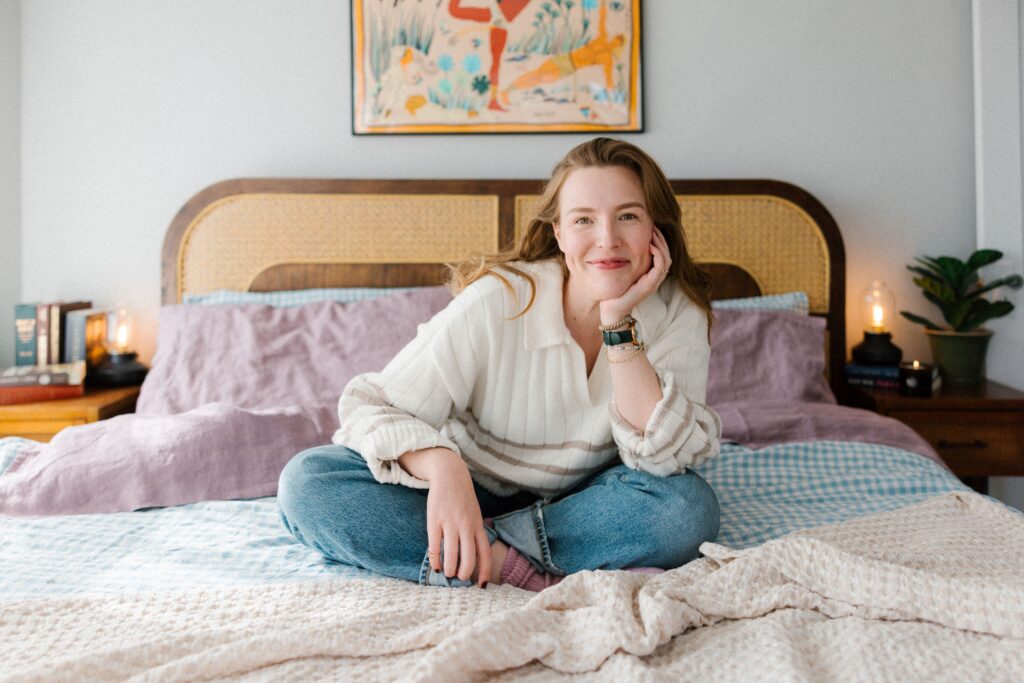
Q+A
Jessica Hanley
Piglet in Bed
Jessica Hanley started homeware brand Piglet in Bed in her mum’s Sussex shed in 2017, selling quality, sustainable linen bedding with a scruffy chic. Instagrammers loved it, helping the business capitalise on the pandemic-era DTC boom, with sales surging sixfold between 2019 and 2021.
Hanley raised $8.5 million from private equity house Active Partners that year to fund further growth, much of which has been in the US, and took the brand into retail in 2023. Its most recent reported turnover stood at £7.5 million.
She shares her experience with Retail Index from her home near Chicago.
You started small but gradually built a loyal, engaged customer base. Tell us about the idea and building the business in those early days.
When I was growing up, people expressed their identity almost exclusively through their clothing. Homewares were simple and clean and well-looked after, but it wasn’t about personal expression. I think the rise of Instagram meant people could project their identity inside their homes too. So we always set out to take what felt like a utility purchase and turn it into a fun, joyful experience, like a fashion purchase.
We were bootstrapped for four years, and while that’s great for building a brand the way you want to build it, it does mean you’re tiny at the start. That requires emotional fortitude. Moving home with my mum in the countryside helped a lot, because it created some distance from my normal life and career [in marketing and PR]. It meant I didn’t have to keep being asked whether we were having much growth, when the answer was no.
Why did you decide to expand out of linen to include high-quality sustainable cotton?
Linen was great. We caught that trend at just the right time, when there was a massive shift towards sustainably sourced materials. But it is still a relatively small part of the market, so we knew that to become a category-defining lifestyle brand, we needed to expand into other areas.
We started with a very small product range, and only worked with one factory in China for quite some time, though the bulk of production has since shifted to Portugal. They were fantastic, despite how tiny our orders were. Back then, our product development process was really just picking Pantone colours. If we said it would be nice to do a tablecloth, our factory would say no problem and handle it. We grew our businesses together.
When we did our fundraising in 2021, we became aware through investor due diligence how unusual it was that we had no merchandising or new product development function. That led to us hiring the right people to enable us to launch into new categories, including other fabrics and towels, which have really skyrocketed our growth.
You expanded to the United States in 2019, and now you live there. How important has that been to Piglet’s growth?
Massively. Our US business is roughly the same size as our UK business and it is going be where our most considerable growth comes from. In terms of me being over here, I will admit that was motivated by me marrying an American, rather than a strategic decision!
But I think if we were only UK based we would have a little less optimism. I can look around here and see how much my neighbours are spending, all the new Teslas that keep showing up, and it gives me confidence that there’s a lot of shopping happening.
When we launched in the US, there were a lot of conversations about how much we needed to adapt the product range and tone of voice. The answer was not at all. We’ve leaned into our Britishness. Americans are buying florals, and mixing and matching quirky patterns, which is seen as a British cottage style, whereas in the UK a lot of people come to us for their white linen and oatmeal cottons.
You also opened your first retail store last year. How does that fit into your future plans?
Our first retail store was in Harrogate, then we opened in Bath and Tunbridge Wells. It’s really exciting. We brought in a great head of retail from Mint Velvet, who has had a massive role in shaping our retail strategy. But every single one of our teams has had to learn a new way of working. We’re learning a lot about how to make these stores perform to a high level, bringing the community together and meeting our customers.
We’ve realised for example that there’s a gap for beautiful, giftable items. Our stores are very bedding focused, and there’s an incredible online halo effect in the local area. But sleepwear and towels are doing really well in-store, which is telling us people want pickup items. It’s also revealed an exciting opportunity for bath and body products, which we’re working on for late next year.
“I used to hide in the toilets because I didn’t have money for the train tickets,” he admits, but describes the feedback as vital. “It evolved into personal trainers wearing the product and we’d give them royalties if their clients bought it, which was a kind of pre-social media influencer marketing. It worked very well.”
The brand grew through word of mouth, with the help of a loan from Virgin StartUp and money from their parents remortgaging their home.
An early break occurred in 2019, when Andy Murray noticed his trainer wearing Castore. That led to a new product range, AMC, worn by Murray in front of millions, and even resulted in the tennis star investing in the business.
“We were probably too small to do a partnership of that size. If you went to Harvard Business School – which I did not, because I left school at 16 – I suspect they would teach you to build the infrastructure, scale and experience first. But we said the opportunity is there now and it might not be next year or next month. Bite off more than you can chew, and then chew like crazy,” Beahon says.
New opportunities: Partnerships and retail
A key part of the brothers’ original business hypothesis was that there was an opportunity for a smaller sportswear brand like theirs to partner with the sports teams that don’t get deals with Nike or Adidas to supply their kit.
“Unless you’re Real Madrid or Man United or Munich or Liverpool, you generally don’t get a bespoke, designed kit,” Beahon explains, adding that sports clubs outside the global elite also generally lack the marketing and digital infrastructure to sell at scale.
“Nike will do $50 billion in revenue this year, give or take. Sometimes scale is powerful, but when you’re doing $50 billion it’s just not economically viable to focus on growing the revenues of a mid level or aspirational Premier League football team. Their scale is our opportunity.”
The first partner to sign up was the West Indies cricket team in 2020, followed by the likes of Rangers, Wolverhampton Wanderers, the McLaren and later Red Bull F1 teams, Saracens rugby club, Bayer Leverkusen, Sevilla and many more.
Simultaneously, the brothers went into physical retail, opening their first store in Chelsea in 2019. They now have 20. Although Beahon describes DTC as the engine of Castore’s growth, he is a big believer in bricks and mortar as a way to capture more demand.
“Not everyone is sitting on Instagram when they want to buy a product. People do like to go shopping so they can discover your brand, feel your product, and talk to a human about it,” he says. “The two channels augment each other. When we open a store we can see the revenue spike online in that location. If you get the mix right, it can be a very powerful combination.”
Funding growth
Whatever Castore is doing, it’s doing it right. By 2021, the business was turning over £17 million. The following year, it hit £48 million. Last year, it was £115 million. Equally impressively, it has achieved this rampant growth alongside healthy margins since its early days, last year returning a pre-tax profit of £14.7 million.
“Paradoxically, I actually think we may have been too profitable. It’s a first world problem,” Beahon says, explaining that there’s a balance between making growth sustainable and sacrificing short-term results for long-term growth.
While Castore is roundly in the black, it is not bootstrapped, financing growth growth in seven investment rounds beginning with angels Arnauld Massenet, co-founder of Net-a-Porter, and former Saatchi and Saatchi boss Robert Senior in 2018, with other notable backers including EG Group’s Issa Brothers.
The most recent investment was a $150 million round led by US VC Raine, which valued Castore at £950 million.
Beahon wouldn’t recommend the fundraising experience for everyone (“anyone who says it’s not distracting hasn’t done one… it can make a good business a lot better and accelerate it, but don’t do it thinking it will make a mediocre business better”), but he has been able to use the funds to develop growth opportunities in international markets.
Although Castore has had a global presence since it started signing international teams, it has had particular success in Europe. Sales there jumped from £900,000 in 2022 to £25.3 million in 2023 – growth made possible by deals with major European sports clubs like Feyenoord and Sevilla, and by the decision to open a warehouse in Rotterdam during the pandemic, which helped it escape the export red tape that has since entangled many British firms.
Castore also recently signed a sub-licensing deal with Umbro, allowing it to market Umbro-branded kit associated with the latter’s partner teams, which Beahon says will allow it to generate more economies of scale in its distribution and digital platforms.
Although there have been setbacks along the way, including a high-profile decision by Aston Villa to ditch the brand over shirts that they said retained sweat, Beahon asserts that Castore is always looking to improve the performance of its products, by sticking to its vision: to make the kind of sports kit that sports people want to wear.
That, he argues, is at the heart of being a great retailer. “We’re not looking to be a fashion brand, following the latest trend. It’s knowing who your customer is and what you’re doing to make their lives better. That’s a fundamental truth for brands and retailers. Methods and technologies will constantly evolve, but the core foundation of knowing why you exist will never change.”

